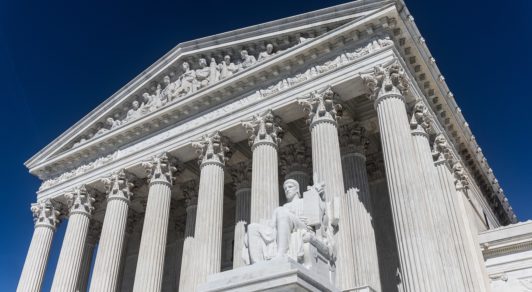Abortion rights, women of color, and LGBTQI+ people are under attack. Pledge to join us in fighting for gender justice.
Roe v. Wade did far more than establish the right to abortion; it solidified and expanded the constitutional “right to privacy,” which has also been described as the right to autonomy or to be let alone. This right to privacy is part of the right to liberty protected by the Fifth and Fourteenth Amendments, which state that no person shall be deprived of “life, liberty or property, without due process of law.”1 These rights are in jeopardy now that Roe has been overturned.
The Constitution’s protection of liberty and privacy underlies the Supreme Court’s recognition of fundamental rights related to contraception and procreation, marriage, family relations, child rearing, and intimacy.2 Although the Supreme Court’s recognition of the right to privacy predates Roe, Roe was an important affirmation of and foundation for a broad array of privacy and liberty rights.3 While not exclusively dependent on Roe, Roe influenced privacy and liberty principles in each of these areas—principles that are now in jeopardy because the Supreme Court overturned Roe in Dobbs v. Jackson Women’s Health Organization.
The Right to Contraception and the Right to Procreate
Roe reaffirmed prior decisions protecting individuals’ rights to contraception and to decide whether to bear a child.4 Subsequent cases upholding the right to contraception, in turn, rely on Roe. For example, a 1977 Supreme Court case overturned a law that restricted distribution of nonprescription contraceptives to adults and prohibited the sales or distribution of contraceptives to individuals under 16. The case explicitly relied on Roe for its central holding that “the Constitution protects individual decisions in matters of childbearing from unjustified intrusion by the State.”5
The Right to Marry
Loving v. Virginia acknowledged the constitutional right to marry, and Roe affirmed that it is among the fundamental liberties protected by the right to privacy.6 Subsequent cases protecting the right to marry have relied on Roe. For example, a 1978 Supreme Court decision upheld the right of single parents obligated to pay child support to marry without first obtaining the permission of a judge,7 and based this conclusion in part on Roe.8 This same fundamental liberty right was reaffirmed as recently as 2015 by the Supreme Court in a case that guaranteed same-sex couples the right to marry.9
The Right to Maintain Family Relationships
The right that underlies Roe also protects family relationships.10 For example, the Supreme Court relied on Roe to hold that the state cannot interfere in the realm of family life by preventing close relatives from living together.11 As the Supreme Court put it, a zoning regulation that banned a grandmother from living with her grandson, “slic[ed] deeply into the family itself . . . by select[ing] certain categories of relatives who may live together and declar[ing] that others may not.”12 The Supreme Court went on to say that courts used Roe to “consistently acknowledge[] a ‘private realm of family life which the state cannot enter.’”13
The Right to Make Decisions About How to Rear One’s Children
Parents’ right to raise their children according to their preferences is also protected by the same fundamental constitutional right. The Supreme Court has relied on Roe as important support for the proposition that “[a] person’s decision whether to bear a child and a parent’s decision concerning the manner in which his child is to be educated may fairly be characterized as exercises of familial rights and responsibilities” and thus protected by the Constitution.14 While these rights related to parental decision-making were recognized before Roe,15 Roe relied on and strengthened the underlying principle—that parenting is best when free from unwarranted government intrusion.16
The Right to Intimacy
Another right profoundly influenced by Roe is the right to form intimate relationships and the related right for adults to engage in consensual sexual relations in private. This right was first recognized in a 2003 Supreme Court decision striking down laws that criminalized same-sex intimate activity.17 The case proclaimed that “Roe recognized the right of a woman to
make certain fundamental decisions affecting her destiny and confirmed once more that the protection of liberty under the Due Process Clause has a substantive dimension of fundamental significance in defining the rights of the person,” such as autonomy in decision-making about intimate relationships.18
The Right to Personal Control of Medical Treatment
The right affirmed in Roe also includes the right to make other kinds of medical decisions. For example, the Supreme Court in 1990, influenced by Roe and the liberty interest doctrine, extended the right to the ability to appoint a healthcare proxy and refuse unwanted medical treatment.19 The Supreme Court later confirmed that Roe recognized the importance of receiving medical intervention.20
The Court’s legally unjustifiable decision to overturn Roe v. Wade puts these rights in jeopardy. The analytical framework used by the majority in Dobbs lays out a roadmap for revisiting and taking away these other fundamental rights. And Justice Thomas states this goal clearly.21 He calls for the Court to overrule the caselaw that established these rights, specifically mentioning cases guaranteeing the right to birth control, intimate relationships, and marriage equality.22
But these rights have recognized our fundamental dignity and freedom, and allowed us to thrive. As the dissent in Dobbs made clear, “[t]he Court’s precedents about bodily autonomy, sexual and familial relations, and procreation are all interwoven–all part of the fabric of our constitutional law, and because that is so, of our lives.”23 Losing more of these fundamental rights would create even more devastation across the country, further undo the gains we have made over the past 50 years, and destroy our constitution and democracy.



